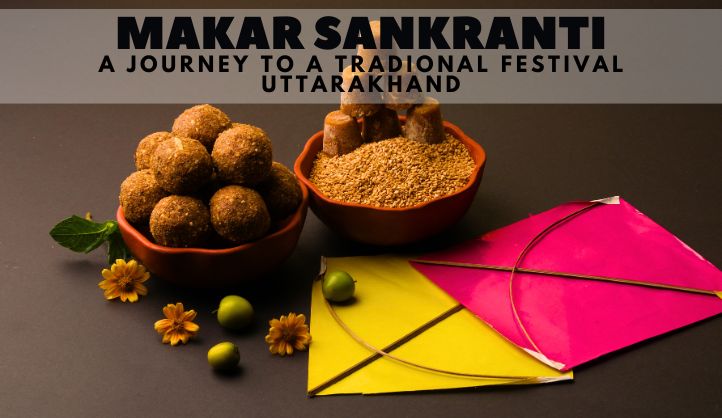Nestled in the foothills of the Himalayas, Uttarakhand vibrates with a unique blend of culture and tradition. One of its most cherished festivals, Makar Sankranti, transcends religious boundaries and paints the state with joyous hues. Known as “Ghughutia” in the Kumaon region and “Khichdi Sankranti” or “Gholdiya” in Garhwal, this festival celebrates the Sun’s northward journey, marking the end of harsh winters and the dawn of a brighter, warmer season.
A Day of Astronomical and Spiritual Significance
Makar Sankranti falls on January 14th (or 15th in leap years) every year, coinciding with the Sun’s transition from the zodiac sign Sagittarius (Dhanu) to Capricorn (Makara). This astronomical phenomenon signifies the beginning of Uttarayana, a six-month period when days become longer and the sun moves northward. In Hindu scriptures, this northward movement is seen as a period of auspiciousness, marking a shift towards longer, brighter days and renewed life.
Festivities Steeped in Tradition
The spirit of Makar Sankranti permeates every corner of Uttarakhand. Here’s a glimpse into the vibrant tapestry of traditions that unfold during this joyous occasion:
- Ritualistic Bathing: Devotees throng to sacred rivers like the Ganga, Saryu, and Gomti in Bageshwar and the Gaula in Ranibagh for a holy dip. This ritualistic bath, known as “Makar Snan,” is believed to cleanse the body and soul, ushering in good fortune for the year ahead.
- Worshiping Surya, the Sun God: Sunrise on Makar Sankranti witnesses prayers and offerings dedicated to Surya, the Sun God. People chant mantras, and light diyas (earthen lamps), and express gratitude for the life-sustaining warmth of the sun.
- Sharing and Charity: The spirit of generosity flourishes during Makar Sankranti. Aromatic Khichdi, a dish made with rice, lentils, and spices, is prepared and shared with family, friends, and the underprivileged. This practice, known as “Khichdi Daan,” embodies the values of compassion and community.
- Sweet Delights: Homes are filled with the aroma of til (sesame seeds) as families prepare delectable treats like til ke laddoo (sesame seed fudge) and gajak (brittle made with sesame seeds and jaggery). These sweet treats are exchanged with loved ones, symbolizing the sweetness of life and togetherness.
The Enthralling Uttarayani Mela
The Kumaon region comes alive with the vibrant Uttarayani Mela during Makar Sankranti. Held for a week around the festival, this fair is a cultural extravaganza. The picturesque grounds of the Bagnath Temple in Bageshwar transform into a bustling marketplace, showcasing the region’s rich heritage. Folk artists enthrall audiences with soulful renditions of Jhoras, Chancharis, and Bairas (local folk music). The air thrums with the rhythmic beats of the dhol (drum), while skilled artisans display their mastery in creating iron and copperware, baskets, and colorful textiles. Visitors can immerse themselves in the vibrant cultural tapestry, savoring local delicacies and picking up unique souvenirs.
Kite Flying Frenzy
Makar Sankranti is synonymous with kite flying, a tradition that transcends age groups. Dotting the clear blue skies are kites of all shapes and sizes, their vibrant colors creating a mesmerizing spectacle. The spirit of competition thrives as participants engage in friendly duels, trying to outmaneuver each other’s kites with threads coated with glass powder. The sight of kites soaring high above, bathed in the warm winter sun, embodies the joy and optimism associated with the festival.
Makar Sankranti: A Celebration Beyond Religion
While Makar Sankranti has deep-rooted religious significance, it transcends religious boundaries and fosters a sense of community. It’s a time for families to come together, strengthen bonds, and celebrate the simple joys of life. The festival also serves as a reminder of the importance of gratitude for nature’s bounty and the cyclical nature of life.
A Glimpse into Local Customs
- Haldi Kumkum: In Kumaon, women apply a paste of turmeric and vermillion (haldi kumkum) to each other’s foreheads, symbolizing good luck and prosperity.
- Ghughutia Ritual: Unique to the Kumaon region, the Ghughutia ritual involves throwing puffed rice (murmura) mixed with jaggery and sesame seeds onto rooftops. This practice is believed to ward off evil spirits and invite good fortune.
Experiencing Makar Sankranti in Uttarakhand
If you seek an authentic experience of Makar Sankranti, head to Uttarakhand in mid-January. Witness the holy dips in the sacred rivers, savor the delectable Khichdi, and lose yourself in the vibrant chaos of the Uttarayani Mela. Here are some specific suggestions to make your experience truly unforgettable:
-
Bathing in the Holy Rivers: Head to Bageshwar on the banks of the Saryu River or to Triyuginarayan, nestled amidst breathtaking Himalayan landscapes, to witness the Makar Snan. Be prepared for crowds, but the spiritual aura and picturesque setting are worth the experience.
-
Uttarayani Mela: Immerse yourself in the cultural extravaganza of the Uttarayani Mela in Bageshwar. Explore the bustling marketplace, be enthralled by folk performances, and witness the skill of local artisans. Don’t forget to indulge in local delicacies of Uttarakhand like Bhatt ki churma (a savory dish made with lentil dumplings) and Singori (a sweet dish made with lotus seeds).
-
Kites and Competition: Join the kite-flying frenzy! Purchase a colorful kite from a local vendor and head to an open field. Watch the sky transform into a mesmerizing canvas of vibrant colors as kites battle for supremacy. Embrace the friendly competition and let the spirit of joy fill your heart.
-
Homestay Experience: For a truly immersive experience, consider staying in a homestay during Makar Sankranti. This allows you to connect with local families, witness traditional customs firsthand, and savor home-cooked meals prepared with love.
Beyond the Festivities: Exploring Uttarakhand
While Makar Sankranti offers a unique window into the culture of Uttarakhand, extend your trip to explore the state’s other treasures. Hike amidst the majestic Himalayas, embark on a spiritual pilgrimage to Char Dham (four sacred Hindu pilgrimage sites), or simply relax amidst the serenity of nature.
Conclusion
Makar Sankranti in Uttarakhand is more than just a festival; it’s a celebration of life, renewal, and the interconnectedness of nature and community. Witnessing the vibrant traditions, indulging in the delectable food, and soaking in the warm winter sun is an experience that will leave a lasting impression. So, pack your bags, embrace the spirit of festivity, and embark on a journey to discover the magic of Makar Sankranti in Uttarakhand.
FAQs About Makar Sankranti in Uttarakhand
1. When is Makar Sankranti celebrated in Uttarakhand?
Makar Sankranti is celebrated on January 14th (or 15th in leap years) every year.
2. What are some key traditions observed during Makar Sankranti in Uttarakhand?
- Holy dips: Devotees take ritualistic baths in sacred rivers like the Saryu and Gomti.
- Worshiping Surya: Prayers and offerings are made to Surya, the Sun God.
- Sharing Khichdi: A dish called Khichdi is prepared and shared with family, friends, and the underprivileged.
- Sweet treats: Delicacies like til laddoo and gajak are made and exchanged.
- Uttarayani Mela (Kumaon region): A vibrant fair showcasing local culture and crafts.
- Kite flying: A popular activity for all ages, with colorful kites filling the sky.
3. What is the significance of the Uttarayani Mela?
The Uttarayani Mela is a week-long fair held in the Kumaon region during Makar Sankranti. It’s a cultural extravaganza featuring folk music, dance performances, displays of local crafts, and a bustling marketplace.
4. What are some unique customs observed in Uttarakhand?
- Haldi Kumkum (Kumaon): Women apply a paste of turmeric and vermillion to each other’s foreheads for good luck.
- Ghughutia ritual (Kumaon): Throwing puffed rice, jaggery, and sesame seeds onto rooftops to ward off evil spirits.
5. How can I experience Makar Sankranti in Uttarakhand?
- Witness the holy dips in Bageshwar or Triyuginarayan.
- Immerse yourself in the Uttarayani Mela.
- Participate in the kite flying tradition.
- Opt for a homestay experience to connect with locals.
- Explore other cultural and natural wonders of Uttarakhand.





